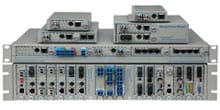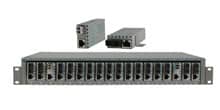- Products
- PoE Media Converters and Switches
- Ethernet & PoE Switches Product Selector
- Multi-Gigabit Ethernet and PoE Switches
- PoE PSE Commercial Switches
- PoE PSE Industrial Fiber Switches
- PoE Industrial Copper Extenders
- PoE Powered Media Converters
- PoE PSE Media Converters
- PoE Extenders & Injectors Product Selector
- Pluggable Transceivers Product Selector
- Single Pair PoE Products
- Product Lines

- iConverter Managed Multi-service Platform
- Copper to Fiber Media Converters
- Ethernet Media Converters
- 10 Gigabit Copper-to-Fiber
- 10/100/1000 Copper to 10 Gigabit Fiber
- 10/100/1000 Copper-to-Fiber with Integrated Management
- 10/100/1000 Industrial Copper-to-Fiber with Integrated Management
- 10/100/1000 Copper-to-Fiber with VLAN
- 10/100/1000 Dual Media Converter with VLAN
- Gigabit Copper-to-Fiber
- 10/100 Copper-to-Fiber with Integrated Management
- 10/100 Industrial Copper-to-Fiber with Integrated Management
- 10/100 Copper-to-Fiber with VLAN
- 10/100 Copper-to-Fiber
- Fast Ethernet Copper-to-Fiber
- Fast Ethernet Redundant Links
- 10Mbps Copper-to-Fiber
- 10Mbps Copper to Coax
- TDM Media Converters
- Serial Media Converters
- Ethernet Media Converters
- Fiber to Fiber Media Converters
- 10 Gigabit Fiber-to-Fiber Converter and Transponder
- 10 Gigabit Industrial Converter and Transponder
- SFP-to-SFP Fiber Converter and Transponder
- SFP-to-SFP Industrial Fiber Converter and Transponder
- Gigabit Fiber to-Fiber with 3 Rs
- 100/1000 Fiber-to-Fiber with 3 Rs
- Gigabit Fiber-to-Fiber
- Fast Ethernet Fiber-to-Fiber with 3 Rs
- Fast Ethernet Fiber-to-Fiber
- OC-3/STM-1 Fiber-to-Fiber
- OC-12/STM-4 Fiber-to-Fiber
- Carrier Ethernet Network Interface Devices
- CE 2.0 - 10G Demarcation NID
- CE 2.0 - 10G Demarcation and Aggregation NID
- CE 2.0 - 10/100/1000 Mult-port NID
- CE 2.0 - 10/100/1000 Mult-port NID with PoE
- CE 2.0 - 10/100/1000 8-Port NID
- SFP NID - Gigabit SFP NID
- microNID - 100/1000 compact NID
- CE 1.0 Service OAM - 10/100/1000 NID
- CE 1.0 Link OAM - 10/100/1000 Copper-to-Fiber NID
- CE 1.0 Link OAM - 10/100 Copper-to-Fiber NID
- CE 1.0 Link OAM - Gigabit Fiber-to-Fiber NID
- CE 1.0 Link OAM - Fast Ethernet Fiber-to-Fiber NID
- CWDM Multiplexers
- T1/E1 Multiplexers
- Ethernet Switch Modules
- Management System
- Chassis Options

- 1-Module Industrial Chassis

- RuggedNet Industrial Switches and Extenders
- Industrial PoE PSE Fiber Switches
- Multi-Gigabit Managed Industrial PoE+/BT Switches
- Multi-Gigabit Unmanaged Industrial PoE+/BT Switches
- 10G Managed 802.3bt PoE Switches
- 10G Unmanaged 802.3bt PoE Switches
- 10G Managed PoE+ Switches
- 10G Unmanaged PoE+ Switches
- 1G Managed PoE+ Switches
- 1G Unmanaged PoE+ Switches
- 1G Unmanaged 802.3bt PoE Switches
- 1G Managed 802.3bt PoE Switches
- Industrial SPE Switches
- Industrial Ethernet Switches
- Industrial PoE Copper Extenders
- Industrial Power Supplies

- OmniConverter Media Converter, Switches and Extenders
- PoE PSE Media Converters
- 10G Multi-Gigabit / Multi-Rate PoE Media Converter
- 10G Multi-Gigabit / Multi-Rate Media Converter
- 10/100 Multi-port PoE+ Media Converter
- 10/100 PoE+ Media Converter
- 10/100/1000 Multi-Port PoE+ Media Converter
- Industrial 10/100/1000 Multi-Port PoE+ Media Converter
- 10/100/1000 PoE+ Media Converter
- 10/100/1000 PoE++ 60W-100W Media Converter
- Industrial 10/100 Multi-port PoE+ Media Converter
- 1U Rack-Mount Shelf
- PoE PSE Compact Switches
- Multi-Gigabit Managed PoE+/BT Switches
- Multi-Gigabit Unmanaged PoE+/BT Switches
- 10G Managed 802.3bt PoE Switches
- 10G Unmanaged 802.3bt PoE Switches
- 10G Managed PoE+ Switches
- 10G Unmanaged PoE+ Switches
- 1G Managed PoE+ Switches
- 1G Unmanaged PoE+ Switches
- 1G Managed 802.3bt PoE Switches
- 1G Unmanaged 802.3bt PoE Switches
- Ethernet Switches
- PoE Copper Extenders
- Single Pair Ethernet (SPE)
- PoE Injectors

- miConverter Unmanaged Miniature Media Converters
- 10/100/1000 Copper-to-Fiber
- Industrial 10/100/1000 Copper-to-Fiber
- 10/100/1000 Ultra-Compact Copper-to-Fiber
- Gigabit Copper-to-Fiber
- 10/100/1000 Copper-to-Fiber PoE Powered
- 10/100 Copper-to-Fiber
- 10/100 Ultra-Compact Copper-to-Fiber
- 10/100 Copper-to-Fiber PoE Powered
- 18-Module Chassis
- Industrial 10/100 Copper-to-Fiber PoE Powered

- FlexSwitch Compact Switches
- Solutions
- Company
- Support
- How to Buy
Understanding the Distinction Between a Transceiver and a Module

In telecommunications and networking, two commonly used terms are "transceiver" and "module." While these two terms may seem interchangeable, they represent distinct components with unique functionalities. Let's look into the disparities between transceivers and modules, shedding light on their roles, capabilities, and applications.
What Is a Transceiver?
A transceiver, short for transmitter-receiver, is a device that combines both transmission and reception functions into a single unit. It serves as the interface between a device and a network, facilitating data exchange over communication channels. Transceivers are integral to various communication systems, including Ethernet, fiber optic networks, and wireless technologies.
What Is a Module?
On the other hand, a module refers to a compact, self-contained unit that performs specific functions within a larger system. Modules can encompass various functionalities like data processing, signal conversion, or protocol adaptation. These modular components are designed for versatility and ease of integration, allowing for flexible configurations in diverse applications.
1. Differentiating Characteristics
Form Factor
One of the primary distinctions between transceivers and modules lies in their form factors. Transceivers typically come in standardized form factors, such as SFP (Small Form-factor Pluggable) or XFP(10-gigabit small form-factor pluggable), which ensure compatibility across various networking equipment. In contrast, modules may vary in size, shape, and interface, depending on their intended purpose and application.
Functionality
While transceivers focus on data transmission and reception, modules encompass a broader spectrum of functionalities. Modules can include components such as processors, memory chips, or specialized circuits, enabling them to perform specific tasks within a system. These additional functionalities make modules adaptable to diverse requirements, ranging from data storage to signal modulation.
Interchangeability
Transceivers are often designed for interchangeable use, allowing them to be swapped or replaced without significant modifications to the host device. This interchangeability enhances flexibility and scalability in network deployments, enabling seamless upgrades or replacements as needed. Modules, however, may be tailored to specific applications, limiting their interchangeability across different systems.
2. Applications and Use Cases
Transceiver Applications
Transceivers find extensive applications in telecommunications, networking, and data centers. They are crucial in transmitting and receiving data over various mediums, including optical fibers, copper cables, and wireless channels. Common use cases for transceivers include Ethernet connections, fiber optic links, and wireless communication systems.
Module Applications
Modules are utilized in myriad applications across industries, such as telecommunications, computing, and industrial automation. They serve as building blocks for assembling complex systems, providing specialized functionalities tailored to specific requirements. Examples of module applications include data storage modules, sensor interfaces, and protocol converters.
| Feature | Module | Transceiver |
|---|---|---|
|
Type |
active or passive |
Active |
|
Function |
Performs a specific function |
Designed for transmitting and receiving signals |
|
Replaceability |
Often integrated |
User-replaceable |
|
Application |
Diverse applications (power conversion, signal processing) |
Telecommunication (fiber optics, wireless) |
FAQs
What Is the Difference Between a Media Converter and a Transceiver Module?
A media converter facilitates the conversion of signals between different media types, like copper to fiber optics. At the same time, a transceiver module handles the transmission and reception of data within the same medium. Essentially, a media converter acts as an interface to bridge the gap between disparate media types, whereas a transceiver module focuses on communication within a single medium.
What Is the Difference Between an Sfp and a Transceiver?
SFP (Small Form-factor Pluggable) refers to a specific form factor for transceiver modules. While a transceiver is a broader term encompassing devices that combine transmission and reception functions, SFP specifically denotes a compact, hot-swappable transceiver module commonly used in networking equipment. In essence, SFP is a type of transceiver module characterized by its small form factor and standardized interface.
Is a Media Converter a Transceiver?
While both media converters and transceivers serve roles in communication networks, they fulfill distinct functions. A media converter primarily focuses on signal conversion between different media types, whereas a transceiver combines transmission and reception functions within the same device. Therefore, a media converter is not technically a transceiver, although both contribute to the efficiency and flexibility of communication systems. Note that you can insert some SFP transceivers into media converter modules.
What Are the Components of a Transceiver?
A transceiver typically comprises several essential components, including a transmitter, receiver, oscillator, amplifier, and signal-processing circuitry. While the receiver recognizes incoming signals and transforms them into usable data, the transmitter converts electrical signals into a format appropriate for transmission. Additionally, the oscillator generates the carrier frequency, and the amplifier boosts signal strength, ensuring reliable communication over the network.
Conclusion
Transceivers and modules are fundamental components in modern communication and networking systems. While transceivers focus on data transmission and reception, modules offer versatility and specialized functionalities within larger systems. It is imperative to comprehend the differences between these two components in order to develop and implement scalable and effective communication infrastructure.
Omnitron offers SFP (Small Form-Pluggable) and 10 Gigabit SFP+/XFP optical transceivers, which are interchangeable, compact media connectors. These transceivers enable a single network device to connect to a broad range of copper and fiber cable types and distances.
Omnitron's SFP and SFP+ transceivers are based on the MSA (Multi-Source Agreement) industry standards SFF-8472 and INF-8077i, which ensures interoperability between different vendors' SFP and SFP+ transceivers. This allows you to use Omnitron SFP and SFP+ transceivers in a variety of network devices. Call us now to get pre-sale support.









